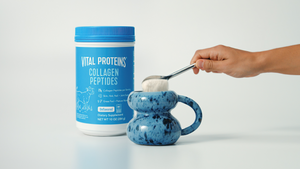Many times throughout the year, especially the holidays, can be hectic and leave you feeling overwhelmed. Learning to cultivate a gratitude practice, or thankful appreciation of the goodness in our lives, can help support a positive mindset.
Gratitude doesn't need to be reserved only for significant occasions, such as a promotion. You can also be thankful for something as simple as a tasty meal or a walk with a good friend. Scroll on down to learn more about why showing a bit of gratitude is important and expert advice about how to incorporate doing so in your everyday routine.
The importance of showing gratitude
As Dr. Carla Marie Manly, clinical psychologist, speaker and author of Joy from Fear notes, a regular gratitude practice is important for our emotional well-being from both a neurobiological and psychological perspective. She adds that whatever we tend to think toward the most — be it positive or negative — will become more prominent within the self. "Thus, if we focus on gratitude and being appreciative, we will be more upbeat and grateful. And conversely, if we focus on negativity, or what we don’t have, the mind will become more focused on the negative," she says. "This phenomenon is the result of the strengthening of neural pathways; the more we engage in any recurring thought or behavior, the stronger that neural pathway will become."

5 Easy gratitude exercises to get started
"In working with both groups and individuals, I have certainly found that those who put a greater focus on appreciation and gratitude tend to feel more joyful and positive overall," says Dr. Manly, adding that once the gratitude practice becomes hardwired in the brain, an uplifting gratitude routine will tend to flow naturally. Here are some suggestions from our experts about how you can regularly incorporate expressing a bit of thanks in your day-to-day:
1. Do the happiness challenge: Whenever you're experiencing any type of distress (i.e. frustration with the pandemic or anger at a loved one), Dr. Elizabeth Lombardo, psychologist and best-selling author, recommends partaking in something she calls the “happiness challenge,” where you pause and force yourself to identify three things you appreciate right now. “Let’s say you are tired of working from home,” she says. "Take a moment and appreciate that (1) you have a job; (2) you have a safe place to work; and (3) you can take a break and hug your dog whenever you want."
2. Fill your gratitude jar: “A ‘gratitude jar’ is a terrific appreciation-creating technique,” says Manly. To create a gratitude jar, all you need is a clear glass or jar, a pen and some paper. “When you think of a blessing in your life, simply write it on a slip of paper and tuck in into the gratitude jar. Over time, the lovely bits of paper fill up the glass or jar with true evidence of gratitude,” she says. Dr. Manly also points out that the sheer visual reinforcement of seeing the jar filled with one’s blessings can be tremendously uplifting in itself. "And, if a person feels low or rundown, a quick reading of one of the gratitude phrases can be a reminder of staying grateful and appreciative," Manly notes.

3. Create a gratitude list: Dr. Julie Pike, licensed psychologist and anxiety disorder specialist who regularly appears on Sirius Radio’s Doctor Radio and was on TLC’s Hoarding: Buried Alive for four years, suggests making a list each morning about what you’re thankful for and why. She adds that if you really want to hone your skills, you might even add a third column about what you’re doing today to illustrate that gratitude. "For example, I'm grateful for my mother because she is so supportive, caring and loving, and to demonstrate that I'm going to call/text her and tell her I appreciate her," she says. Pike also points out that the demonstration of gratitude doesn’t have to be anything more than a "thought, text, prayer, compliment or smile."
4. Keep a gratitude journal: Expanding on the list idea, think about keeping a gratitude journal to jot down the positive elements of life. "A gratitude journal — a place in which one can consciously focus on and outline blessings and appreciation — is a space to enliven one’s sense of thankfulness whether the day’s entry is a sentence or several paragraphs," says Manly.
5. Begin and end your day with simple gratitude offerings: Another tip from Manly is to train the mind to say five gratitude statements upon waking and another five as you hit the pillow at the end of the day. "These simple rituals can train the brain into being focused on the joys of life and overall positivity," she tells Lively.
Related Articles
Make gratitude a habit
It's important to note that gratitude should be practiced on a consistent basis to really reap the benefits. “The purpose of something like a gratitude list is to regularly practice widening our perspective, experiencing joy and balancing our days,” says Dr. Pike. "It's a muscle that needs to be worked, like any other, and practicing daily means that when something goes wrong, you will be more likely to quickly see the positive aspects within a negative situation."
Lombardo adds that when practicing, you should let yourself "sit" in that gratitude, "feeling the love, appreciation and positive energy that this brings you."













